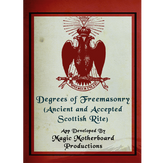
Description
Scottish Rite. French writers call this the " Ancient and Accepted Rite," but as the Latin Constitutions of the Order designate it as the " Antiquus’ Scoticus Ritus Acceptus," or the " Ancient and Accepted Scottish Rite," that title has now been very generally adopted as the correct name of the Rite. Although one of the youngest of the Masonic Rites, having been established not earlier than the year 1801, it is at this day the most popular and the most extensively diffused. Supreme Councils or governing bodies of the Rite are to be found in almost every civilized country of the world, and in many of them it is the only Masonic obedience. The history of its organization is briefly this. In 1758, a body was organized at Paris called the “Council of Emperors of the East and West.” This Council organized a Rite called the " Rite of Perfection," which consisted of twenty-five degrees, the highest of which was “Sublime Prince of the Royal Secret.” In 1761, this Council granted a Patent or Deputation to Stephen Morin, authorizing him to propagate the Rite in the Western continent, whither he was about to repair. In the same year, Morin arrived at the city of St. Domingo, where he commenced the dissemination of the Rite, and appointed many Inspectors, both for the West Indies and for the United States. Among others, he conferred the degrees on M. Hayes, with a power of appointing others when necessary. Hayes accordingly appointed Isaac Da Costa Deputy Inspector-General for South Carolina, who in 1783 introduced the Rite into that State by the establishment of a Grand Lodge of Perfection in Charleston. Other Inspectors were subsequently appointed, and in 1801 a Supreme Council was opened in Charleston by John Mitchell and Frederick Dalcho. There is abundant evidence in the Archives of the Supreme Council that up to that time the twenty-five degrees of the Rite of Perfection were alone recognized. But suddenly, with the organization of the Supreme Council, there arose a new Rite, fabricated by the adoption of eight more of the continental high degrees, so as to make the thirty-third and not the twenty-fifth degree the summit of the Rite. The Rite consists of thirty-three degrees, which are divided into seven sections, each section being under an appropriate jurisdiction.
-
Scottish Rite
-
Ancient and Accepted Rite
-
Albert Pike
-
Albert Mackey
